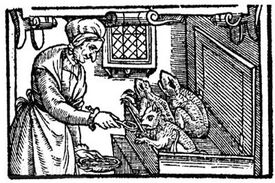
English engraving from 1579 which shows a witch feeding her familiars.
In folklore and fiction, a familiar (also called a familiar spirit or a familiar animal) is a spirit, fairy or demon in the form of an animal (on very rare occasions in the form of a person) which accompanies and assists a witch, wizard or warlock. Most of what is known about familiars today comes from transcripts of witch trials from 16th and 17th century England and Scotland, in which familiars are often referred to as imps. The main function of familiars was said to be protecting a young person who was just beginning to learn witchcraft. Familiars are said to be shape-shifters who can take on any form they like but they are often imagined as taking the forms of cats, owls, bats, rats or toads.
According to the transcripts of witch trials, there are three different ways in which somebody could come into possession of a familiar. The familiar may be gifted to a young person by someone else, such as an older relative, a more powerful spirit or the Devil himself. The familiar may suddenly and unexpectedly appear to somebody who has never thought about practicing magic before while that person is going about his or her daily business in the house or garden. The familiar may appear to someone who has cried out for help in desperation, usually as a result of poverty, unemployment, illness or extreme sadness following the death of a relative. The familiar offers to teach the unfortunate person magic, saying that it will get the person out of his or her desperate situation.

Illustration from Matthew Hopkins' 1647 book The Discovery of Witches which shows witches identifying their familiars.
It has been suggested that the origins of the fairy tales Rumpelstiltskin, the Frog Prince and Puss in Boots have a connection with belief in familiars. In each of those stories a talking animal or other supernatural being approaches someone in a desperate situation. The unusual creatures offer to use their great skills to get the person out of trouble.
Witches, wizards and warlocks are usually said to be able to summon their familiars whenever they please. However, Elizabeth Chandler of Huntingdon, England, accused of being a witch in 1646, said that she had no control over when her two familiars Beelzebub and Tulibub appeared and that she began to pray that they would leave her alone.
Familiars are often imagined as having strange or demonic names but that is not always the case. Bessie Dunlop of Dalry, Ayrshire, Scotland, burned at the stake for being a witch in 1576, said that she had a familiar called Tom Reid.

Prince Rupert and Boye in an illustration from the 1643 The Cruel Practices of Prince Rupert.
The German-born soldier Prince Rupert of the Rhine, who fought for King Charles I's Royalists against Oliver Cromwell's Parliamentarians during the 1642-1651 English Civil War, was said by his enemies to have a familiar in the form of his dog Boye, a white hunting poodle which accompanied the prince everywhere, including into battle. Prince Rupert's Royalist supporters made fun of their enemies' beliefs, publishing pamphlets which said that Boye was a woman from Lapland who had been changed into a dog, that Boye was completely invulnerable, could catch bullets in its mouth and predict the future. Boye was killed during the 1644 Battle of Maston Moor. It is rumored to have been shot with a silver bullet.
The concept of familiars has been adopted by some Wiccans and other neopagans. They continue to feature in works of fiction concerning people with magical powers. Although companion owls, cats, rats and toads feature in J.K. Rowling's Harry Potter series, the word "familiar" is not used in any of the seven novels and there is no suggestion that they are spirits in disguise. However, familiars often feature in Harry Potter fan-fiction.
External links
- Wikipedia's article on familiar spirit.
- Familiar on TV Tropes & Idioms.
